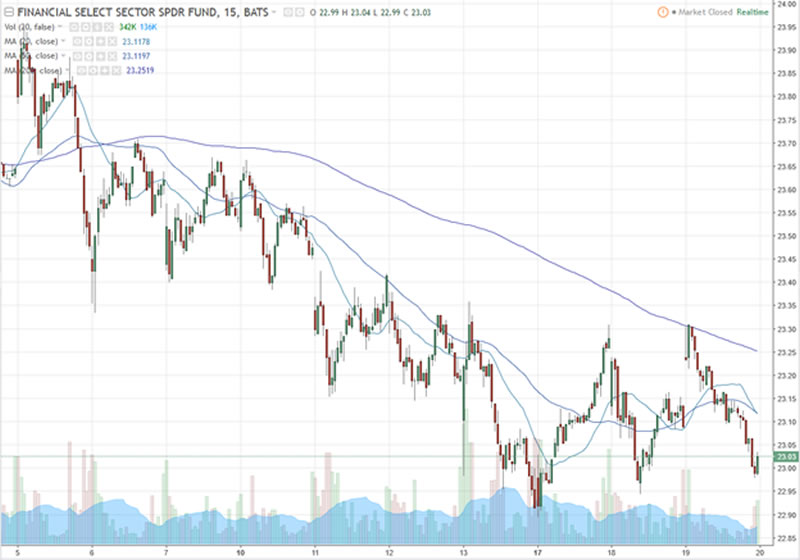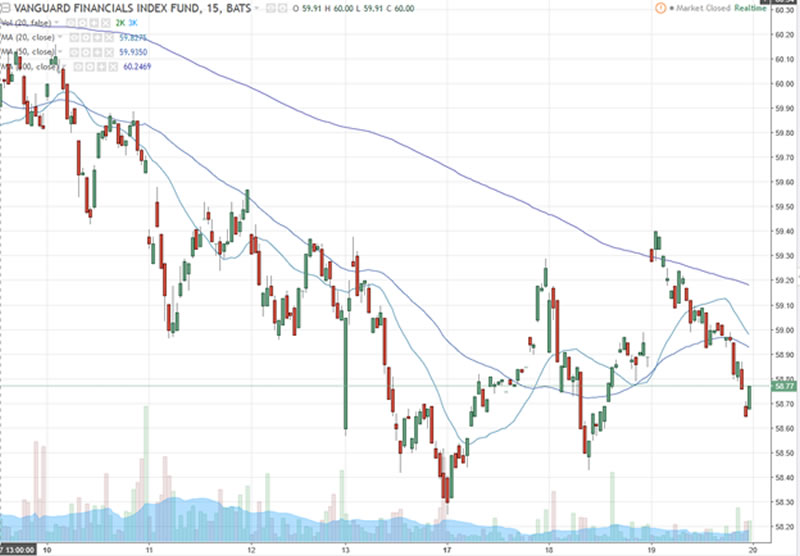Volatile Week for Financial ETFs
Stock-Markets / Exchange Traded Funds Apr 21, 2017 - 12:24 PM GMTBy: Nicholas_Kitonyi

 Earnings season is around, and it tends to add some volatility back into the market. Now, major banks and financial firms have already reported their earnings, most beat expectations. However, there were also mixed results with financials. Goldman Sachs Group Inc (NYSE: GS) and Morgan Stanley (NYSE: MS) were some notable earnings that surprised the Street. Consequently, this added some volatility to exchange-traded funds (ETFs), such as the Financial Select Sector SPDR Fund (NYSEARCA: XLF) and Vanguard Financials ETF (NYSEARCA: VFH).
Earnings season is around, and it tends to add some volatility back into the market. Now, major banks and financial firms have already reported their earnings, most beat expectations. However, there were also mixed results with financials. Goldman Sachs Group Inc (NYSE: GS) and Morgan Stanley (NYSE: MS) were some notable earnings that surprised the Street. Consequently, this added some volatility to exchange-traded funds (ETFs), such as the Financial Select Sector SPDR Fund (NYSEARCA: XLF) and Vanguard Financials ETF (NYSEARCA: VFH).
Financial ETFs and Major Bank Earnings
The Financial Select Sector SPDR Fund aims to provide investors with investment results corresponding to the general price and yield performance of the Financial Select Sector Index, its underlying index. Some of the ETF’s top holdings include JPMorgan Chase & Co. (NYSE: JPM), Bank of America Corp (NYSE: BAC), Wells Fargo & Co (NYSE: WFC), Citigroup Inc (NYSE: C), Goldman Sachs Group Inc, and Morgan Stanley.
JPMorgan Chase beat the Street estimate, after reporting a diluted EPS of $1.65, while the consensus estimate was $1.52. Wells Fargo beat the Zacks consensus EPS estimate by 3 cents per share, after the company had organic growth buoyed by deposit balances and loans. Bank of America also beat the Street’s EPS estimate by 6 cents.

Source: TradingView.com
Take a look at the chart above, you’ll notice how XLF has been experiencing some volatility around earnings, and this could be attributed to the movements in its largest holdings.
According to trader Jason Bond, “Generally, if one of the largest holdings in an industry or sector ETF move, the other holdings could move in sympathy, which could lead to some volatility in the fund. For example, we saw this when Goldman Sachs reported its earnings results, which surprisingly missed analyst estimates, this dragged some stocks in the industry down. In turn, this caused some financial ETFs to finish down on the day.”
The Vanguard Financials ETF is similar to XLF, with its top holdings also including JPM, WFC, BAC, C and GS. In similar fashion, VFH was affected by some of its stop holdings, and experienced some volatility due to some mixed earnings results.

Source: TradingView.com
Goldman Sachs missed the consensus EPS estimate, as well as the consensus revenue estimate, which caused the stock to fall to a four-and-a-half-month low on the day it released its earnings results. Moreover, the company announced its equities trading revenue fell by approximately 6% year over year. Now, the stock had some volatility the day of its earnings, which actually dragged down some other stocks in the banking sector, leading to some volatility in XLF, as you can see on the chart, on April 18, 2017. Similarly, if you look at VFH, the performance that day looks nearly identical to XLF.
One trader stated, “Heading into the earnings, all eyes were on MS because Goldman Sachs reported earnings the day before, and the markets wanted to see how MS would perform in relation to GS.”
Similarly, if a large holding in a sector ETF rises, the entire ETF could rise. Morgan Stanley surprised Wall Street, after Goldman Sachs reported earnings below the consensus estimate. However, MS reported better-than-expected quarterly results, which was primarily attributed to its trading and investment banking operations. What was most surprising was its fixed income trading revenue for the quarter, which doubled year over year.
In previous charts of XLF and VFH, you’ll notice on April 19, 2017, when MS released earnings, XLF gapped up. However, it ended up filling the gap and selling off, now this was primarily due to the overall market pressure.
The Take Away
Earnings season can be very hectic, as we’ve just seen with some companies in the financial services industry. Typically, if one of the largest holdings in a sector ETF moves, the entire fund could move. So when considering, trading or investing in sector ETFs, you’ll want to be mindful of the fund’s top holdings and any events surrounding them.
By Nicholas Kitonyi
Copyright © 2017 Nicholas Kitonyi - All Rights Reserved Disclaimer: The above is a matter of opinion provided for general information purposes only and is not intended as investment advice. Information and analysis above are derived from sources and utilising methods believed to be reliable, but we cannot accept responsibility for any losses you may incur as a result of this analysis. Individuals should consult with their personal financial advisors.
© 2005-2022 http://www.MarketOracle.co.uk - The Market Oracle is a FREE Daily Financial Markets Analysis & Forecasting online publication.


